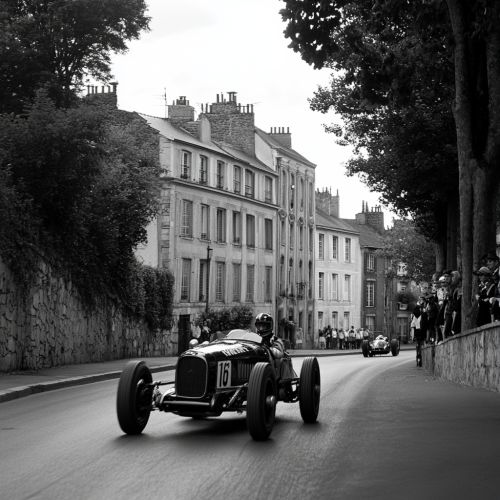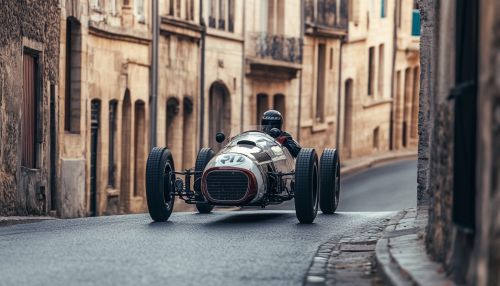Angoulême City Grand Prix: Difference between revisions
(Created page with "== History == The Angoulême City Grand Prix, known in French as the "Circuit des Remparts d'Angoulême," is a historic motorsport event held annually in the city of Angoulême, France. The event traces its origins back to 1939, when the first race was organized to celebrate the city's rich automotive culture and its picturesque medieval architecture. The circuit, which winds through the narrow streets and past the ancient city walls, has become renowned for its cha...") |
No edit summary |
||
| Line 15: | Line 15: | ||
The circuit's historic nature means that safety measures have to be carefully integrated without compromising the integrity of the ancient cityscape. | The circuit's historic nature means that safety measures have to be carefully integrated without compromising the integrity of the ancient cityscape. | ||
[[Image:Detail-97993.jpg|thumb|center|Vintage race cars navigating a tight corner in the historic streets of Angoulême.|class=only_on_mobile]] | |||
[[Image:Detail-97994.jpg|thumb|center|Vintage race cars navigating a tight corner in the historic streets of Angoulême.|class=only_on_desktop]] | |||
== Categories and Classes == | == Categories and Classes == | ||
Latest revision as of 07:55, 15 September 2024
History
The Angoulême City Grand Prix, known in French as the "Circuit des Remparts d'Angoulême," is a historic motorsport event held annually in the city of Angoulême, France. The event traces its origins back to 1939, when the first race was organized to celebrate the city's rich automotive culture and its picturesque medieval architecture. The circuit, which winds through the narrow streets and past the ancient city walls, has become renowned for its challenging layout and scenic backdrop.
The inaugural race in 1939 was a significant event, attracting notable drivers and a large audience. However, the outbreak of World War II led to the suspension of the event until 1947. Post-war, the Grand Prix resumed and quickly gained a reputation for its unique combination of historic charm and competitive racing.
Circuit Layout
The Angoulême City Grand Prix circuit is approximately 1.279 kilometers (0.795 miles) in length. The track is characterized by its tight corners, elevation changes, and narrow streets, making it one of the most challenging urban circuits in the world. The layout includes several notable sections:
- **La Montée des Remparts**: A steep uphill section that tests the power and handling of the cars.
- **Place Beaulieu**: A tight hairpin turn that requires precise braking and acceleration.
- **Rue de la Cloche Verte**: A narrow, winding street that demands expert navigation.
The circuit's historic nature means that safety measures have to be carefully integrated without compromising the integrity of the ancient cityscape.


Categories and Classes
The Angoulême City Grand Prix features a variety of racing categories, catering to different types of vehicles and drivers. These include:
- **Historic Grand Prix Cars**: Pre-war and post-war single-seaters that have participated in Grand Prix events.
- **Classic Sports Cars**: Iconic sports cars from the 1950s to the 1970s.
- **Vintage Touring Cars**: Historic touring cars that have competed in various national and international championships.
- **Modern Classics**: More recent classic cars that have achieved iconic status.
Each category is further divided into classes based on engine capacity, age, and other technical specifications.
Notable Drivers and Cars
Over the years, the Angoulême City Grand Prix has attracted numerous notable drivers and iconic cars. Some of the most famous participants include:
- **Juan Manuel Fangio**: The legendary Argentine driver who competed in the early post-war races.
- **Stirling Moss**: The British racing icon known for his versatility and skill in various types of cars.
- **Bugatti Type 35**: One of the most successful racing cars of the 1920s, often seen at the event.
- **Ferrari 250 GTO**: A highly coveted classic sports car that has graced the streets of Angoulême.
Event Organization
The organization of the Angoulême City Grand Prix is a complex task that involves coordination between various stakeholders, including the local government, motorsport clubs, and sponsors. Key aspects of the organization include:
- **Safety Measures**: Ensuring the safety of drivers, spectators, and residents is paramount. This includes installing barriers, safety nets, and medical facilities.
- **Logistics**: Managing the transportation and accommodation of participants, as well as the setup and dismantling of the circuit infrastructure.
- **Promotion**: Marketing the event to attract spectators and participants from around the world.
Cultural and Economic Impact
The Angoulême City Grand Prix has a significant cultural and economic impact on the city and the surrounding region. The event attracts thousands of visitors each year, boosting local tourism and hospitality industries. Additionally, the Grand Prix serves as a platform to showcase Angoulême's rich history and cultural heritage.
The event also fosters a sense of community and pride among residents, who actively participate in the organization and celebration of the Grand Prix. The race weekend is often accompanied by various cultural activities, exhibitions, and parades, further enhancing its appeal.
Preservation of Heritage
One of the unique aspects of the Angoulême City Grand Prix is its commitment to preserving automotive heritage. The event not only features historic cars but also promotes the restoration and conservation of these vehicles. Several organizations and clubs dedicated to vintage and classic cars play a crucial role in this effort.
The Grand Prix also collaborates with museums and archives to document and preserve the history of the event and the cars that participate. This includes maintaining records, photographs, and memorabilia that provide valuable insights into the evolution of motorsport.
Future Prospects
The future of the Angoulême City Grand Prix looks promising, with ongoing efforts to enhance the event while preserving its historic charm. Key areas of focus include:
- **Sustainability**: Implementing environmentally friendly practices to reduce the event's carbon footprint.
- **Innovation**: Incorporating modern technologies to improve safety, logistics, and spectator experience.
- **Expansion**: Exploring opportunities to expand the event's reach and attract a more diverse range of participants and spectators.
